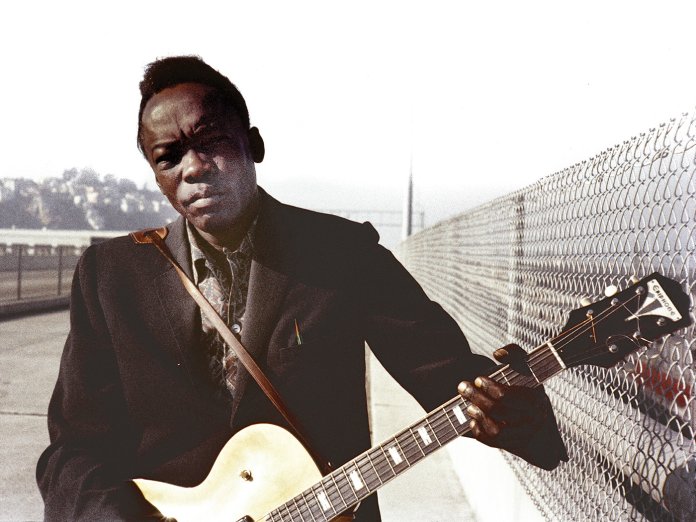John Lee Hooker wrote his biggest hit because he just couldn’t get to work on time. After scoring a residency at the Apex Bar in Detroit in the early 1940s, he developed a habit of showing up well after his first set was supposed to begin, and the bartender – a woman named either Willow or Willa – would regularly cock her finger like a gun, point at him, and scold the bluesman: “Boom boom, you’re late again.” Eventually he realised there might be a song in that rhythmic declaration, and Hooker began playing around with a start-stop composition. Always behind schedule, he didn’t actually record it until nearly 20 years later, but “Boom Boom” became one of his biggest hits and arguably his most enduring composition.
A lusty strut with a leering guitar lick and a tight call-and-response with his backing band – which included members of the Funk Brothers, already renowned as the house band at Motown – “Boom Boom” opens Hooker’s 1962 album Burnin’, a masterpiece of electrified Detroit boogie blues and his greatest long-player. Sixty years later, it sounds like a pivotal album, a foundational text for the blues-rock explosion of the mid-1960s. “Boom Boom” was quickly covered by The Animals, The Yardbirds, Them and seemingly every other skinny white guy who picked up a guitar in the 1960s, not to mention Dr Feelgood
on their ’75 debut. Hooker encouraged the attention and even recorded with many of his acolytes later in the ’60s, ensuring that blues would remain in rock’n’roll’s DNA.
Born to sharecroppers outside Clarksdale, Mississippi, in either 1912 or 1917, Hooker ran away to Memphis as a teenager and cut his teeth busking on Beale Street, then headed north to Detroit. He worked at the Ford factory during the day and played local clubs at night, and when the city crowds got too noisy, he traded his acoustic guitar in for an electric, which helped to distinguish Detroit blues as something very different – heavy, industrialised, modern – from the more acoustic sound favoured down South.
He scored his first hit with “Boogie Chillen” in 1949 and continued recording throughout the 1950s. He hit his creative and commercial peak at the height of the folk revival, which resurrected the careers of so many blues artists, but Hooker didn’t really need a kickstart. He’d never stopped recording or performing, and while he did briefly recast himself as a rural bluesman, which was the trend at the time, the role never really fitted him.
As a guitar player and as a performer, Hooker had his own sense of timing. In addition to running late to gigs, he rarely stuck to a strict tempo or played a song the same way twice, which made it difficult for backing musicians to keep up. In that regard, Burnin’ is a small miracle. Hooker’s longtime pianist, Joe Hunter, corralled members of the Funk Brothers to play on these sessions. They were already renowned for playing on Motown’s earliest hits, including The Miracles’ “Shop Around” and The Marvelettes’ “Please Mr Postman” (both from 1960), but they sound grittier here, a little rowdier but not less precise or evocative, as though they were enjoying a little more freedom away from Hitsville USA.
The Funk Brothers rein Hooker in. The rhythm section of drummer Benny Benjamin and bassist James Jamerson keeps these songs tight and focused, lending “Let’s Make It” its streamlined momentum and “Drug Store Woman” its lowdown gait. The entire band, Hooker included, move and lurch as one organism, with the saxophones adding breathy commentary on the droning “What Do You Say” that barely skirts bawdiness. The music is inventive, sly, even hilarious, like when they borrow the main riff from The Champs’ “Tequila” for “Keep Your Hands To Yourself”, a raucous warning to a romantic rival that sounds more like a party than a scuffle.
But Burnin’ is Hooker’s show, and he proves to be an immensely charismatic frontman, enlivened rather than tamed by his band. His guitar nimbly rides the groove of each song, splitting the difference between rhythm and lead. On the up-tempo songs he raves and howls to cajole the other players along, and on the slower numbers he moans and wails, his talking-blues delivery imbuing plaints like “Drug Store Woman” and “Process” with gravity, menace even.
During the early 1960s folk revival, Burnin’ was an anomaly: a fully plugged-in album that straddles blues and R&B, a beautifully rambunctious collection that makes no gesture toward history but simply ploughs forward into the future of pop music.



